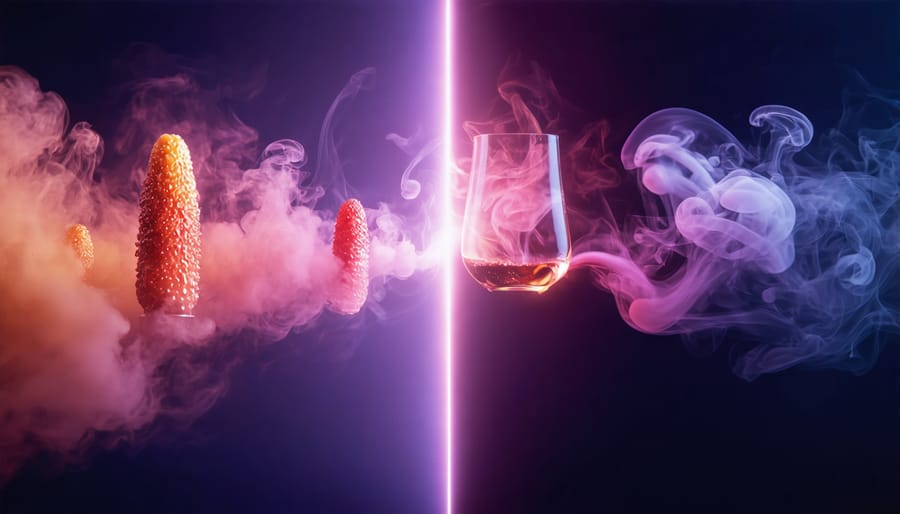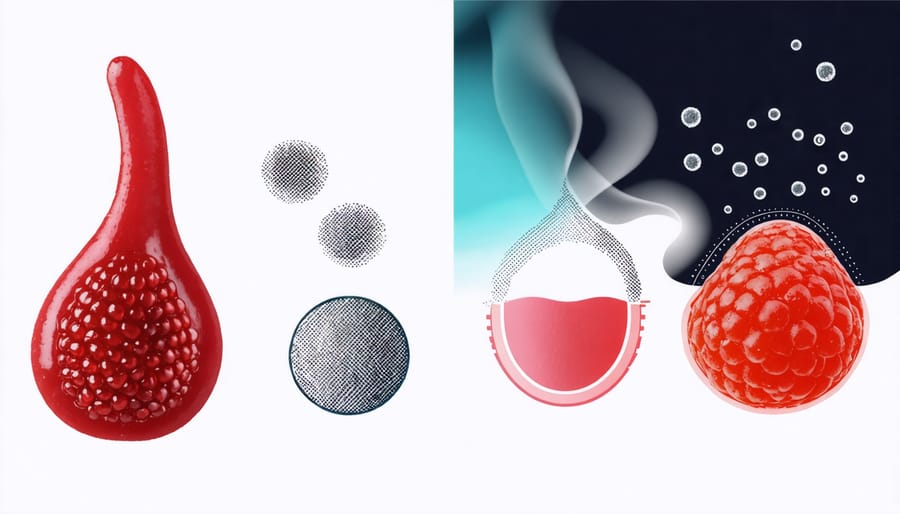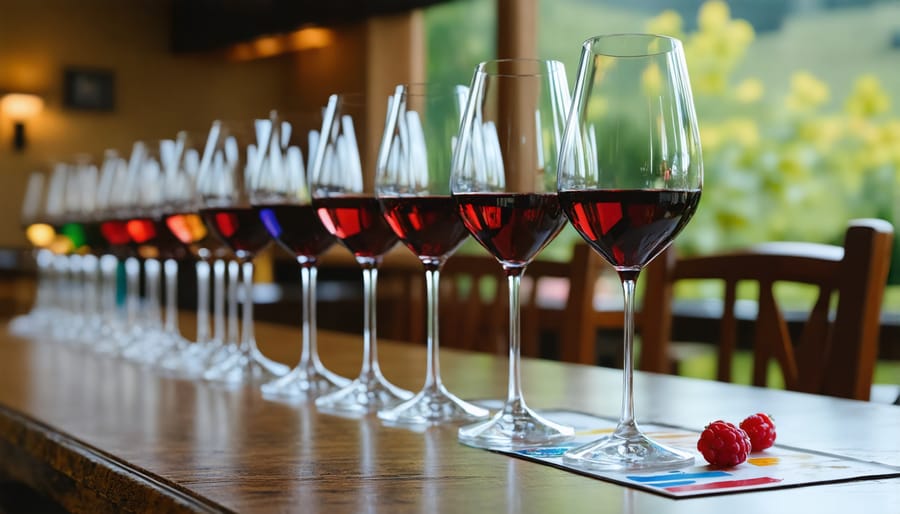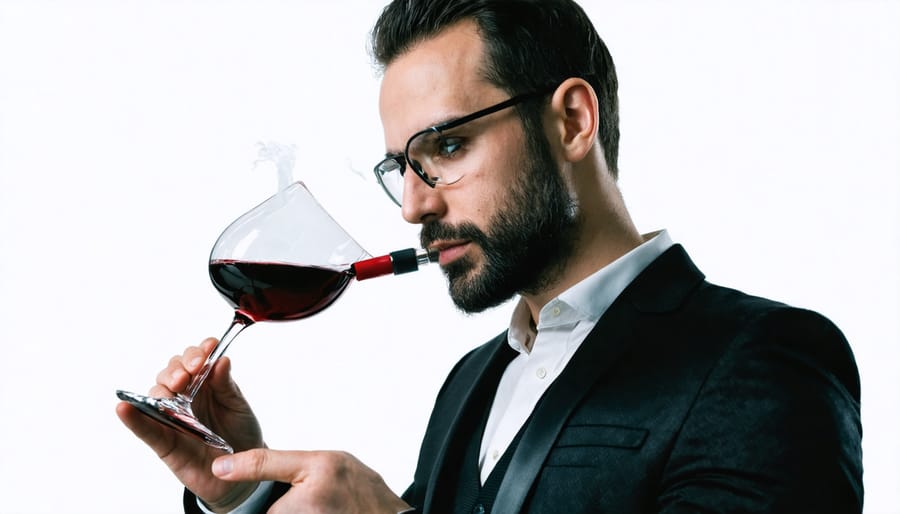



In the evolving landscape of modern wine appreciation, vaping and wine pairing presents both opportunities and challenges for the discerning enthusiast. Understanding wine tasting fundamentals becomes crucial when navigating this intersection of traditional and contemporary pleasures. The rising popularity of premium e-liquids (view collection) has sparked fascinating discussions among sommeliers and vape connoisseurs alike about how vapor affects our perception of wine’s subtle notes.
Recent studies suggest that while vaping can temporarily alter taste receptors, a thoughtful approach to timing and flavor selection can enhance rather than diminish the wine tasting experience. This emerging cultural phenomenon reflects a broader shift in how modern enthusiasts approach traditional wine appreciation, challenging conventional wisdom while creating new opportunities for sensory exploration.
As both industries continue to evolve, understanding their interaction becomes increasingly relevant for today’s wine lover, whether they’re exploring bold Cabernets or delicate Rieslings alongside their preferred vaping choices.
When we sip wine, thousands of aromatic compounds interact with our olfactory receptors, creating the complex flavors we enjoy. Similarly, when we vape, vapor particles come into contact with these same receptors, potentially influencing how we perceive taste. The science behind this interaction lies in the way vapor molecules can temporarily coat our taste buds and nasal passages.
The temperature and density of vapor can temporarily alter our palate sensitivity. Hot vapor may slightly desensitize our taste buds, while cooler vapor tends to have less impact. Additionally, the chemical compounds in vapor can interact with wine’s aromatic molecules, either enhancing or masking certain flavor notes.
Our brain processes both taste and smell through interconnected neural pathways. When vapor particles linger in our mouth and nasal cavity, they can create a temporary filter through which we experience wine’s complex flavors. This is why experienced sommeliers and wine enthusiasts often recommend waiting several minutes after vaping before tasting wine, allowing your palate to reset and ensure the most authentic tasting experience.
Understanding this relationship helps wine lovers who vape make informed decisions about timing their experiences to maximize their wine appreciation.

Just as your palate needs time to reset between wine tastings, it requires recovery time after vaping. Research suggests that the effects of vaping on taste perception can last anywhere from 30 minutes to several hours, depending on factors like the intensity of use and the type of e-liquid consumed.
For optimal wine tasting experiences, we recommend waiting at least two hours after vaping before engaging in serious wine appreciation. This allows your taste buds to regain their full sensory capabilities and ensures you’ll catch all the subtle flavor notes in your wine. Regular vapers might notice that their overall taste sensitivity gradually diminishes over time, potentially requiring longer recovery periods.
To help your palate reset more effectively, consider these steps: drink plenty of water, cleanse your palate with neutral foods like crackers or bread, and practice deep breathing exercises to clear any lingering vapor from your respiratory system. Some wine enthusiasts find that gentle tongue scraping or rinsing with a solution of warm water and salt can help accelerate the recovery process.
Remember, everyone’s physiology is different, so pay attention to how your body responds and adjust your waiting period accordingly.

The interplay between vaping and wine tasting requires thoughtful timing to ensure optimal appreciation of both experiences. To maximize your wine tasting experience, it’s essential to follow proper wine tasting technique and consider the timing of your vape sessions carefully.
As a general rule, avoid vaping immediately before tasting wine. The heat and intense flavors from vaping can temporarily alter your palate sensitivity and potentially mask the wine’s subtle notes. Wine experts recommend waiting at least 15-20 minutes after vaping before sampling any wines to allow your taste buds to reset.
If you’re attending a formal wine tasting or pairing event, consider scheduling your vape breaks between flight transitions or during natural pauses in the tasting sequence. This approach helps maintain the integrity of your tasting experience while accommodating your vaping needs.
For casual wine enjoyment at home, timing your vape sessions after completing your initial wine assessment can help preserve the authentic tasting experience. Once you’ve fully appreciated the wine’s characteristics, you can then enjoy your vape without compromising the wine’s nuanced flavors.
Remember that different vape flavors may interact differently with various wine styles, so pay attention to how specific combinations affect your palate and adjust your timing accordingly.
When transitioning between vaping and wine tasting, properly cleansing your palate becomes essential for maintaining the integrity of your tasting experience. The intense flavors from vaping can significantly impact your ability to detect wine’s subtle notes, making palate cleansing techniques particularly important.
Water is your first line of defense – but not just any water. Room temperature, still water works best as it doesn’t introduce additional sensations that might interfere with your tasting. Take several small sips and gently swish them around your mouth before swallowing.
Plain, unsalted crackers or bread serve as excellent palate cleansers, helping to absorb residual flavors and reset your taste buds. White bread is particularly effective, though avoid strongly flavored varieties that might introduce new taste elements.
For a more thorough cleanse, consider these professional techniques:
– Gentle tongue scraping with a dedicated tool
– Rinsing with a solution of warm water and a tiny pinch of salt
– Taking several deep breaths through your nose to clear aromatic residue
– Waiting at least 15-20 minutes between vaping and wine tasting
Remember to avoid common mistakes like using flavored waters or acidic beverages as palate cleansers. These can introduce new flavors or temporarily alter your taste perception. The goal is to return your palate to a neutral state, allowing you to fully appreciate the wine’s characteristics without interference from previous vaping sessions.
Several misconceptions have emerged around the intersection of wine tasting and vaping, which deserve careful examination. One common myth suggests that vaping has no impact on wine appreciation, but research indicates that both nicotine and flavoring compounds can temporarily affect your palate sensitivity. Understanding these effects helps enthusiasts make informed decisions about their tasting experiences.
Another widespread belief is that waiting just a few minutes after vaping is sufficient to restore full tasting capabilities. However, studies show that nicotine can influence taste receptors for up to 30 minutes or longer, depending on various factors including individual sensitivity and the intensity of use. This temporary alteration can affect your ability to detect subtle flavor notes and appreciate wine’s complex characteristics.
Some enthusiasts mistakenly believe that choosing unflavored vaping products eliminates any impact on wine tasting. While unflavored options may reduce certain interference, the presence of nicotine and other compounds can still influence your palate’s performance. Additionally, the myth that vaping between wine tastings can “cleanse the palate” is incorrect and may actually compromise your tasting experience.
There’s also a misconception that professional wine tasters who vape don’t experience any negative effects. In reality, many industry professionals acknowledge the importance of maintaining a clean palate and typically avoid vaping before or during formal tastings. The belief that expensive wines are immune to these effects is equally unfounded – even the most refined wines require optimal tasting conditions for full appreciation.
Understanding these misconceptions helps wine enthusiasts make better choices about timing their vaping and wine tasting experiences. Rather than combining these activities, consider enjoying them separately to ensure the best possible appreciation of your favorite wines. Remember that your palate is a sophisticated instrument deserving of optimal conditions for wine evaluation.

Leading sommeliers and wine experts have weighed in on the intersection of wine tasting and vaping, offering valuable insights for enthusiasts of both pursuits. Master Sommelier Sarah Chen emphasizes the importance of timing, suggesting a minimum 30-minute gap between vaping and wine tasting to allow your palate to reset. “The residual flavors and sensations from vaping can significantly alter how you perceive various wine styles,” she explains.
James Morrison, a certified wine educator and former vape shop owner, recommends choosing unflavored vaping products when planning to enjoy wine later. “Artificial flavors, especially sweet or fruity ones, can linger on the palate and interfere with the subtle nuances in wine,” he notes. Morrison also suggests staying well-hydrated and using palate cleansers like plain crackers or water between vaping and wine tasting sessions.
Wine consultant Maria Rodriguez points out that temperature control in vaping can impact taste sensitivity. “Higher temperature vaping tends to dull the palate more significantly,” she explains. “If you must vape before a wine tasting, opt for lower temperature settings and take shorter draws.”
The experts unanimously agree that mindful consumption of both wine and vaping products is key. They recommend treating wine tasting as a dedicated experience, separate from casual vaping activities, to fully appreciate the complexities and characteristics of each wine. For serious wine enthusiasts who vape, they suggest considering designated “wine evenings” where vaping is avoided entirely to ensure optimal tasting conditions.
The relationship between wine appreciation and vaping is complex and deserves careful consideration. As we’ve explored, vaping can significantly impact your ability to fully experience wine’s nuanced flavors and aromas. To maintain optimal wine tasting experiences, consider abstaining from vaping several hours before wine tasting events or important wine moments. If you choose to continue vaping, opt for unflavored options and maintain proper hydration to minimize sensory interference. Remember that your palate is a precious tool in wine appreciation, and protecting it ensures you’ll continue to enjoy the full spectrum of flavors that fine wines have to offer. Whether you’re a casual wine enthusiast or a serious connoisseur, being mindful of how vaping affects your tasting experience will help you make informed decisions about both practices.